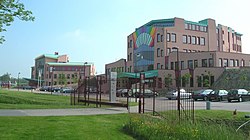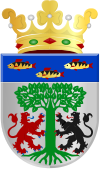Wognum
| Wognum | ||
|---|---|---|
 |
||
|
||
 |
||
| Coordinates: 52°40′N 5°1′E / 52.667°N 5.017°ECoordinates: 52°40′N 5°1′E / 52.667°N 5.017°E | ||
| Country | Kingdom of the Netherlands | |
| Constituent country |
|
|
| Province | North Holland | |
| Municipality | Medemblik | |
| Government | ||
| • Mayor | N. Meijer (VVD) | |
| Area | ||
| • Total | 21.42 km2 (8.27 sq mi) | |
| • Land | 21.37 km2 (8.25 sq mi) | |
| • Water | 0.05 km2 (0.02 sq mi) | |
| Population (2005) | ||
| • Total | 8,130 | |
| • Density | 380/km2 (1,000/sq mi) | |
| Time zone | CET (UTC+1) | |
| • Summer (DST) | CEST (UTC+2) | |
| Website | www |
|
Wognum (![]() pronunciation ) is a former municipality and a town in the Netherlands, in the province of North Holland. Wognum received city rights in 1392 but lost them in 1426. In 2007 it merged with the municipalities of Medemblik and Noorder-Koggenland into the surviving municipality of Medemblik.
pronunciation ) is a former municipality and a town in the Netherlands, in the province of North Holland. Wognum received city rights in 1392 but lost them in 1426. In 2007 it merged with the municipalities of Medemblik and Noorder-Koggenland into the surviving municipality of Medemblik.
The former municipality of Wognum consisted of the following cities, towns, villages and/or districts: Nibbixwoud, Wognum, Zwaagdijk-West, and the hamlet of Wijzend.
Wognum is an ancient place. The place was formed around 900, which is confirmed by archaeological finds. In addition, there seems to be proof, that the area was already inhabited around the Bronze Age. Hand axes and arrowheads from that period were found in the area between the current streets of Oosterwijzend and Dorpsstraat in Wognum.
In 980 the city was first mentioned in a church list of the Abbey of Echternach. The place was named as Wokgunge. In 1063 the city came known as Woggunghem in a charter. There was a chapel where now stands the Reformed Church of Wognum. This chapel belonged to the abbey of Heiloo. Later spellings included Wognem (1083), Woghenem (1156) and Woggenum (1544). The place could refer to the place of the person or family Wok or Wokke. In addition to the West Frisian name Woggem and Woggelum the name was sometimes even (incorrectly) written Wochnum analogous to Wochmar and the old Dutch Wochmeer (Wogmeer).
Wognum is located on the shore of an ancient stream. The shore is composed of sandy soil. Just outside the residential center it is located between Oude Gouw - Kerkstraat and the old peat streams at Baarsdorpermeer / Lekermeer. This is a remnant of the reclamation period from the early Middle Ages. This includes the Kromme Leek, a stream which starts at the Baarsdorpermeer meandering along Wognum through Zwaagdijk and ends at Medemblik. The winding course is preserved as much as possible at the time of the later land consolidation between Wognum and Medemblik.
...
Wikipedia

